Selamat datang ke Bali! (Or “Welcome to Bali!”)
Now that you’re in Bali (or doing some pre-trip planning), you might be wondering just how you should be getting around Bali.
The choice(s) for transportation in Bali may seem very obvious to many, and extremely overwhelming to others. Getting around Bali might not be as simple, compared to what you are used to.
It is not as straightforward as renting an insured car at home, like you would ifyou’re American or Australian, as an example. Or hailing a taxi or booking an Uber as you would in the streets of Manhattan.
(For your information, there is no metro or rail system of any kind in Bali.)
More than likely, you’ll want to plan on using a combination of options that will best suit your individual needs and circumstances.
Factors to consider
What do you have to take into account when considering a mode of transportation to get around Bali?
Here are the most influential factors to be considered:
- Safety
- Price
- Convenience or time
Types of Transportation in Bali:
Walking
Walking can be a great option for many people, not to mention free.
Local infrastructure has been noticeably improving with the addition and repair of sidewalks in many high-tourist areas. Other areas, however, may not be so friendly. The most common areas that are walker-friendly include Kuta, Seminyak (located in North Kuta), Sanur, Ubud, and Nusa Dua.
When I use the term ‘walker-friendly,’ basically that means there is a lot to do or see within a few minutes walking. Think of it as walking in the city versus walking in the suburbs. You walk in the city to get around, while walking in the suburbs is usually just for exercise and fresh air.
Narrow streets
Usually there are good, wide streets. But other streets are more narrow. So it’s important to mention that these may or may not have sidewalks.
For example, when you are walking around the gangs or smaller roads in Kuta, if a car is passing by you’ll have to move out of the way as the road is too narrow for both the car and pedestrians.
This can sometimes cause a blockade of sorts that even pedestrians can’t pass; dozens of motorbikes can surround you as they wait behind a car. It is in this instance that walking is not so pleasant as you suddenly find yourself in a cloud of exhaust fumes.
This is very uncommon on the main streets of any of those areas. And it is extremely rare in Sanur, Ubud, and Nusa Dua.
Local commerce
Most of these areas are quite dense with shops, bars, restaurants, spas, convenience stores, warungs (smaller local restaurants), and more. In the Kuta area, you will be solicited for anything from hotel rooms to drugs to hookers. This can exist in the other areas as well, but it is rampant in Kuta. It is best to ignore these people or politely decline.
Those working in actual shops will more kindly call out asking if you need whatever it is they’re selling, often accompanied by the Australian-influenced words “bloody cheap”. Have a look inside, but unless you are prepared to buy an item don’t bother starting a negotiation.

Be attentive
When walking, always pay attention to your surroundings. The sidewalks are often built over gutter systems and every several meters there is probably an access panel to the open area below. Some of these have been removed or propped up diagonally as a deterrent to motorcyclists wishing to overtake traffic by way of the sidewalk.
Don’t accidentally fall into one of them!
In other areas, the gutter may still exist without cover and you won’t really have anywhere else to walk except for alongside the gutter. It is important to always be conscientious of your surroundings.
More tips when walking
Sneakers are recommended for wet and rainy conditions, as the roads and sidewalks can become quite slippery.
You’ll also likely see shopkeepers ‘watering’ the sidewalk in front of their shop. When I first came to Bali I had no idea why the hell anyone would water anything that wasn’t grass or plants. I quickly learned the purpose of this tactic- it is done to try and minimize the dust in the vicinity.
Walking at night
If you plan on walking at night don’t forget to bring a torch or use the one on your cell phone.
Hati-hati (be careful) if you decide to walk! Kuta is by far the most dangerous area in Bali and personally, I don’t recommend anyone going there at night, especially alone. It doesn’t mean something bad will happen to you if you do, but in my opinion this is the place with the highest risk of crime. A female walking alone at 3am in Kuta is just a bad idea.
Safety – generally safe when using common sense
Price – free!
Convenience or time – convenient in certain areas, not practical in others
Hitchhiking
Although I know people who have done this in Bali and other parts of Indonesia, I strongly recommend not hitchhiking for getting around Bali, especially females. The areas of Kuta, Seminyak and Canggu have become increasingly dangerous for solo female travelers at night. That kind offer for a ride may not be so transparent and most often, something is expected in return.
There are simply too many other choices for transportation in Bali safely for me to say it’s ok to hitchhike here.
Safety – debatably unsafe
Price – usually free
Convenience/time – no guarantees you’ll get a ride
Car (self driven)
Having a car, like anywhere in the world, is a luxury. It’s absolutely wonderful to have a car during the rainy season, when going grocery shopping, and trips to/from the airport. If you’re a surfer, you can bring multiple boards with you, keep a towel and dry clothes, snacks and cold water in the car. If you often travel with others, it’s really nice to go to places as a group.
It’s obviously more expensive than a motorbike and one must factor in the additional petrol, parking fees, yearly taxes (if purchasing a car) and insurance.
Driving license / permit
Police looking for bribe money is something that just about everyone has encountered during their stay in Bali if they have driven themselves. The biggest scam is the fact that most foreigners do not carry a license while driving.
You can prevent this by obtaining an International Drivers Permit (IDP) in your home country before arriving. (Technically, a valid driver’s license from your home country is supposed to accompany your IDP at all times. And although the police in Bali will never ask for it, this could be useful information in the event of an insurance claim).
Also remember that, if you don’t have a motorcycle license at home, your international license won’t permit you to drive a bike in Bali either, only a car.
Another way to go about it is to go one of the large police stations in Denpasar, the Poltables located on Jl. Gunung Sanghyang and obtain a real driving permit for Bali.
Paying for a license or paying a fine/bribe?
The price for these can vary as it depends on how many palms will need to be greased, but a temporary drivers license for 3 months shouldn’t cost more than 300,000 IDR ([convert number=300,000 from=”idr” to=”aud”] AUD / [convert number=300,000 from=”idr” to=”usd”] USD / [convert number=300,000 from=”idr” to=”eur”] EUR). The police do have a way of knowing who is fresh off the boat or not and most long tonger term residents rarely fall victim to the traffic stop.
Many expats simply don’t have any sort of license. They rather choose to handle that problem on the spot with a policeman for a one-time fee of 50,000 IDR ([convert number=50,000 from=”idr” to=”aud”] AUD / [convert number=50,000 from=”idr” to=”usd”] USD / [convert number=50,000 from=”idr” to=”eur”] EUR) or less. For many it is much cheaper to pay a little bit every once in a while, than have to keep renewing a license. If you only get pulled once a year, you will only end up paying about 50,000 IDR per year to the pocket of a policeman. Compare this to 300,000 IDR every three months for a real license. But the moral decision is all up to you.

Rules of the road
Now that you have your license sorted, you need to know the rules of the road in Bali. They are quite easy to remember because there is only one:
watch out for the person in front of you.
While things may seem like a sea of chaos on the streets with people driving aggressively, typically keeping an eye out for the drivers in front of you, including those pulling out in front of you will keep you safe.
In any case, whatever you do, follow traffic laws and drive extremely defensively.
So, what it is like to drive here?
It is mentally exhausting
Driving for one hour here expends the same amount of energy as driving for two hours or more in Australia or America.
The roads are smaller and you’re surrounded by others driving erratically, endless motorbikes zipping around you, pedestrians, cows, dogs, chickens, goats, people with pushcarts, potholes, and so on.
You name it… it’ll probably jump out in front of you when you least expect it. In the main tourist areas, traffic is horrible during rush hour and with the common occurrences of religious ceremonies, it can often be unexpected.
Only those who are extremely confident in their driving ability should drive a car in Indonesia. You’ll learn when and where to drive to avoid sitting in traffic for hours. That’s just the first part.
There is also an inherent risk when getting around Bali while driving a car
The unwritten rule is simply that, as the foreigner, it’s always your fault.
This isn’t meant as a scare tactic but let’s say hypothetically you are involved in an accident in which you are assumed to be at fault. This accident results in the fatality of another party, a local. You could potentially be surrounded by an angry local mob. And this could end in a number of colorful ways.
I’ve also heard of people getting arrested and spending months in jail until they reach an agreement with the victim’s family, usually involving an ‘accidental death’ settlement.
There is no black & white here, no science or reason in these kinds of situations. You might be out 500 USD, or it could end up being 50,000 USD.
Even if you’re not at fault
Foreigners are just about always to blame for accidents in Bali whether it is their fault or not.
A person can blow through a red light and slam right into you at an intersection where your light is green. You could very well end up getting blamed for the incident and held responsible, especially in the financial sense.
If an accident does occur and you are not involved in it, you are better off not sticking around to see what happens. It may seem a bit coldhearted but in the grand scheme of things there is almost nothing you can do to help the situation since the locals have a better knowledge of their own hospitals and ways of handling emergencies.
Take out insurance
Although the ‘normal’, standard automotive insurance (the kind that covers damage to the car you’re driving) is probably included with your rental car (check with the rental agency – see something in writing), I rarely hear of anybody carrying liability/full comprehensive insurance.
It does exist and I highly recommend you consider it a necessity if driving a car. If you need more info about insurance please feel free to contact me for a consultation.
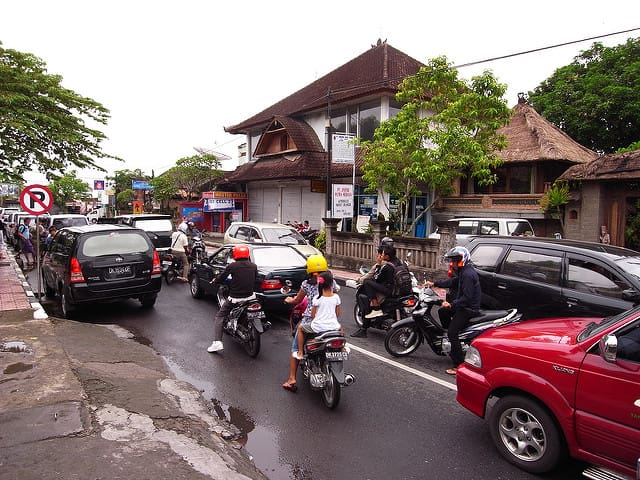
Renting vs. Buying
Renting
If you’re only going to be in Bali a short time, renting will be the best choice.
You can hire a very decent car for 2.5 million IDR ([convert number=2,500,000 from=”idr” to=”aud”] AUD / [convert number=2,500,000 from=”idr” to=”usd”] USD / [convert number=2,500,000 from=”idr” to=”eur”] EUR) per month. Older cars can be found for a little less and newer more luxurious cars can easily double that figure. When renting a car, insurance (the kind covering damage to the car only) may or may not be included.
As mentioned above, make sure you are covered for liability/full comprehensive as well. When renting, the owner should take care of maintenance, registration and yearly taxes.
Buying a car
If you plan on being here for the longer haul it might be more economical to buy a car.
Vehicle ownership does get a bit tricky as foreigners technically cannot legally register a car in their name unless they have a work/retirement KITAS. (KITAS = limited stay permit, usually valid for 1 year or more.)
Only brand new cars (or motorcycles) can be registered in your name if you hold such a limited stay permit.
There are expats out there without a KITAS who have bought their bike with cash at the dealership and it is registered under their name. But there may come a day when the government catches on to them and takes their bike away with no sort of reimbursement. If you have a KITAS then none of this should be any problem.
Registering the car in someone else’s name
If you don’t plan on getting a KITAS, consider the fact that you’d have to put the car into a local’s name, someone whom you can trust.
With current regulations, the person whose name appears on the registration will have to be the one to go pay the yearly taxes OR they can lend their actual identity card (KTP, issued in Bali and still valid) accompanied by a ‘letter of permission’ for someone else to go and pay. Photocopies won’t be accepted as they have been in the past.
Agents can take care of this for varying fees and it will surely save you a lot of time and aggravation. Even if the car is in your name, you might still want to save the time by using an agent. If you are the investigative and curious type, maybe you can try on your own as a ‘social experiment’, as I have – just don’t expect to come out with flying colors. 🙂
Safety – among the safest options for getting around in Bali. Driving a car is much safer than driving a motorbike. Ideal for those who plan on making the island their home. (But, even without immediate safety risk to your health, there is an added risk in the form of exposure to liability, as mentioned above.)
Price – renting 2.5 million+ ([convert number=2,500,000 from=”idr” to=”aud”]+ AUD / [convert number=2,500,000 from=”idr” to=”usd”]+ USD / [convert number=2,500,000 from=”idr” to=”eur”]+ EUR) per month, late model used cars can be purchased for 25 million+ ([convert number=25,000,000 from=”idr” to=”aud”]+ AUD / [convert number=25,000,000 from=”idr” to=”usd”]+ USD / [convert number=25000000 from=”idr” to=”eur”]+ EUR)
Convenience/time – more time on the road, but great if you learn traffic patterns and shortcuts, shopping couldn’t get easier, parking can get annoying
Liability – don’t choose this option if you can’t afford 3rd party liability insurance
Car hire in Bali (with driver)
Car hire in Bali with driver: monthly
This is probably the best solution for those who have any combination of time, money, and children.
A full time driver can be hired with or without a car. Finding a driver with a car is the simplest. Since it’s his car, it’s his liability. You won’t have to worry about maintenance, insurance, or taxes & registration.
Payment
You pay only the salary (which includes the approx. cost of renting a car), petrol, and parking.
Don’t forget to factor in a 13th month of salary; this is usually paid around the most important Hindu holiday of the year, Galungan, which actually occurs twice per year. Sometimes half of the 13th month is given on each Galungan. Just ask your driver which they prefer. If you’ve just hired them and Galungan is really close I suggest you wait until the following Galungan to be sure they’ll be with you for a while.
Schedule and trial period
You’ll want to negotiate the schedule that you require before hiring a driver. Consider the first month a trial period. Expecting to find the perfect driver from day 1 is possible but not common. You might find that he just not the right fit.
If they are needed outside of what most would consider ‘normal’ hours, you should be offering some kind of bonus for the extra time. Many expat families use their driver to drop off and pick up children from school. Sometimes they double as a gardener or handyman, if so, adjust the salary accordingly.
Other jobs on the side
Sometimes the driver may ask to find other transport jobs during school hours. This shouldn’t be an issue as long as they understand the importance of being on time for school pick up. You’d never have to worry about parking, which is certainly nice.
You’ll often see drivers napping in their cars while waiting for their customers. Not a bad gig for them if the salary is fair and they can get some shut-eye during down time.
Many drivers would be willing to go pick up items or small amounts of groceries from the local pasar. If a driver has been with you for months and is performing outstandingly, you should consider gradually increasing the salary over time, as with any position.
Car hire in Bali with driver: daily
There are heaps of freelance drivers available for hire on a daily basis. Prices start at around 400,000 IDR ([convert number=400,000 from=”idr” to=”aud”] AUD / [convert number=400,000 from=”idr” to=”usd”] USD / [convert number=400,000 from=”idr” to=”eur”] EUR) depending on the car and destinations. Sometimes prices include petrol, but never parking. Be sure to clarify before hiring.
It can get pricey when using a daily hire car and driver often, but this is a good option for those needing a car less frequently or for special occasions.
You can find freelance drivers willing to work either daily or monthly by searching some Facebook Groups. Bali Tourist Info and Bali Expats might be a good starting place but you can find many other relevant groups. Use the search function and type ‘monthly/daily driver,’ this should yield significant results.
Safety – safest car-related option
Price – most expensive (excluding the helicopter and assuming you don’t buy a Mercedes to drive on your own 🙂 ), expect to pay at least 5 million IDR/month ([convert number=5,000,000 from=”idr” to=”aud”] AUD / [convert number=5,000,000 from=”idr” to=”usd”] USD / [convert number=5,000,000 from=”idr” to=”eur”] EUR)
Convenience/time – most convenient, more time spent on the road, but you’ll have the freedom to do things while you’re in the car and a helping hand with those groceries
Taxis in Bali
There is certainly no shortage of taxis in Bali. I personally recommend using BlueBird taxis.

While there are many choices, I never use the others. Of the dozens of taxi companies, many have become notorious for offering inflated prices, having tampered meters, or taking longer-than-necessary routes.
A BlueBird driver is required to use the meter when dispatched for a pick-up.
I know several older couples who mostly walk, and then take taxis when needed. They live in the heart of Seminyak. I’d bank on saying they spend less than the cost of a private monthly driver.
Ordering a BlueBird via their call center is best. If, when you get in a taxi, you could ask if they use a meter and/or if they can turn it on, you should never have any surprises.
BlueBirdGroup.com
+62 (0) 361 701 111
There is also a BlueBird app as well, which might be worth a shot.
Safety – comparable in safety to using a car + driver
Price – if using properly ordered (metered) taxis: very reasonably priced
Convenience/time – taxi’s, if ordered in advance, are extremely convenient
Online transportation apps (Uber, Grab, GoCar, etc.)
The use of these apps has become an increasingly sensitive topic in Bali. It’s worth reading my articles about “Uber in Bali” and “Using Uber in Bali“.
Since writing those articles, drama has continued to unfold. Local transportation organizations continue protesting the use of these apps and even in some instances, beating the drivers of these apps. The scene is changing so constantly, it’s hard to say what will be the fate of these online transportation apps. I generally find them highly convenient, professional, and priced fairly.
Anytime I need a ride, Uber is my first choice. Only this month, for the first time did I fail at ordering an Uber from the airport’s International Terminal. The driver seemed afraid to charge such a ‘low fare’ and asked to arrange the pickup on private terms, to which I disagreed. I tried to book another Uber but the same driver kept getting my order. In the end, it was another expat who overheard me on the phone and offered me a ride home at no charge.
In the south of Bali (aka ‘the Bukit’), Ubers are scarce. In Ubud, they exist, but not in large numbers. Please follow my tips on using Uber.
Safety – same as car w/ driver
Price – reasonable
Convenience/time – convenient for shopping, avoid peak traffic hours
Liability – most online transportation companies are insured
Ojek & Go-Jek (motorbike taxi)
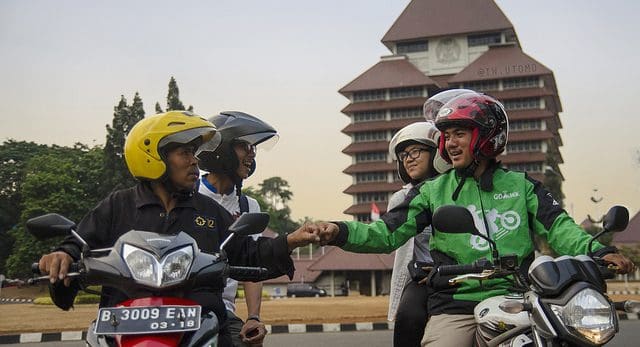
Ojek
Motorbike taxis, or ojek, are used primarily by locals. They are a great way of getting around in Bali. There are ojek posts throughout the island. Using a traditional ojek requires negotiating skills and more than likely the ability to speak Indonesian.
There are officially license ojeks in the touristy areas of Kuta and Seminyak, donning reflective yellow vests with certification numbers.
Unofficial ojeks are pretty much anyone with a scooter looking to make some extra rupiahs on the side- they are everywhere. If you are confident in your negotiating skills they can be of use to you. If they speak English they will probably ask for two to five times the normal price, sometimes exceeding the price of a metered taxi to the same destination.
To get an ojek, simply go to a post or flag one down. If there isn’t one ready to go straight away, I’d keep moving to avoid long waits.
Go-Jek
Go-Jek is the motorbike equivalent of Uber. Much like Uber, it uses a ratings system for all trips and calculates prices automatically and very fairly. You can pre-load the app with credit and eliminate the need to carry cash- there is also an option to tip the driver when paying with this method.
Go-Jek is a great way to get around if you aren’t comfortable driving a motorcycle on your own. The driver will provide a helmet, a facemask, poncho in the event of rain, and best of all they are insured!

The app also offers a plethora of other services with the most popular being ‘Go-Food,’ which contains a massive list of dining options from local eateries selling everything from nasi goreng to Italian-owned pizzerias. Each restaurant has its entire menu listed directly in the app with each item’s price.
Most of their drivers speak a basic level of English, but learning Bahasa Indonesia is always recommended.
Wait times can vary depending on location but the app will show the driver’s location with an estimate of how long it will take them to reach your location at the time of ordering.
Safety – risky/dangerous. (While maybe a little safer than when you’re driving your own scooter -since you’re driven around by a local who was born into the Bali road chaos- it’s still carries an inherent risk.)
Price – budget friendly
Convenience/time – much faster than a car, not so comfortable, waiting times vary depending on location
Scooter/motorcycle
Easily the most convenient, budget friendly, and dangerous way to get around Bali. Driving a scooter or motorcycle requires an immense level of concentration and what I call ‘anticipatory radar.’ All of the hazards mentioned above in the car section will apply to the motorbike with one significant different- the motorbike doesn’t shield you the way a car does. Even if you are the most capable of riders, you are still at risk.
I’m sure your mother says the same thing as my mother, “it’s not you I worry about it’s everyone else.”
Well, mom is right.
Dogs shoot out from roadsides, as do other motorbikes, children, and more. There is a popular saying here regarding motorbike accidents in Bali, “it’s not a matter of IF but a matter of WHEN you’ll have an accident.” We can only hope for everyone’s sake that this is not true.
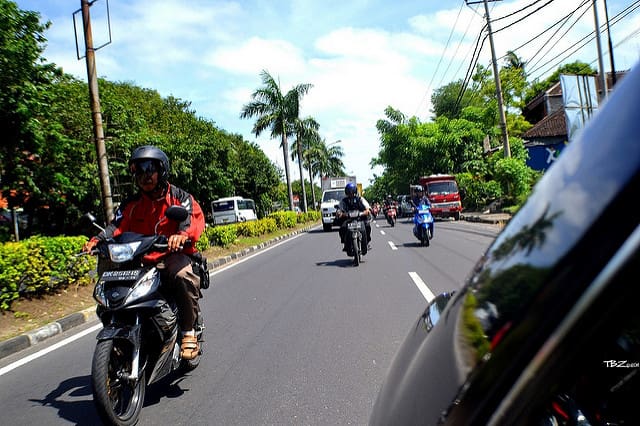
Recommendations
I have some strong recommendations that I urge you to follow…
- NEVER drive under the influence of drugs or alcohol
- Always wear a helmet, full-face recommended
- Always wear eye protection
- NEVER wear sandals
- Obey all traffic laws
- Avoid driving late at night (peak time for drunk drivers & purse snatchings*)
- If you’ve never driven a scooter or motorcycle, Bali is not the place to learn
*A caution
To our female readers- purse snatchings have been on the rise in Kuta, Seminyak, & Canggu. Do not drive alone at night in these areas. If you must, stash your purse inside the scooter’s compartment or in front of you. Don’t wear revealing clothing. Many women use jackets and cover their legs with sarongs. These snatchings have been known to happen even on well-lit roads.
Fairly cheap
On a lighter note, motor bike rental is fairly cheap. The smaller bikes going for 500,000 IDR per month ([convert number=500,000 from=”idr” to=”aud”] AUD / [convert number=500,000 from=”idr” to=”usd”] USD / [convert number=500,000 from=”idr” to=”eur”] EUR), with the average being more like 600,000-700,000 IDR and the bigger bikes like the Honda Tiger going for about 1,000,000 IDR.
Safety – risky/dangerous
Price – economical
Convenience/time – much faster than a car, driving is more comfortable than being a passenger, not pleasant when it rains, limited carrying ability
Liability – make sure you that you are fully licensed (including a motorcycle endorsement) and that your insurance will cover you in Indonesia. Consider the possibility of 3rd party liability insurance (although this is extremely uncommon, it’s a good investment and wouldn’t be expensive).
Bicycle
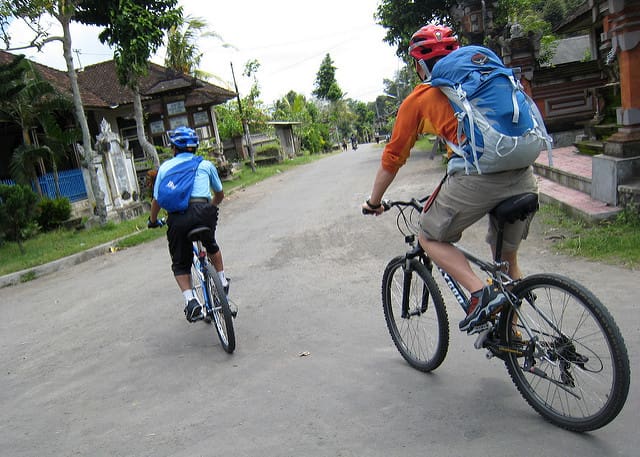
Riding a bicycle around the areas of Sanur, Ubud, and Nusa Dua can be practical and enjoyable. Riding in remote villages is often beautiful and calm. Avoid large roads and riding at night. Although Bali is safe as a whole, try not to leave your bike unattended as theft can occur.
The best type of bike is a cruiser or hard-tail mountain bike. Road bike tires are too narrow for the Bali roads.
Always wear a helmet, as even at low speeds bicycle accidents can be fatal. The use of a flashing headlight and taillight is encouraged when riding at night.
Safety – lower speeds than scooters make this option safer
Price – cheap
Convenience/time – great for short distances in certain areas
Dokar (horse-drawn carriage)
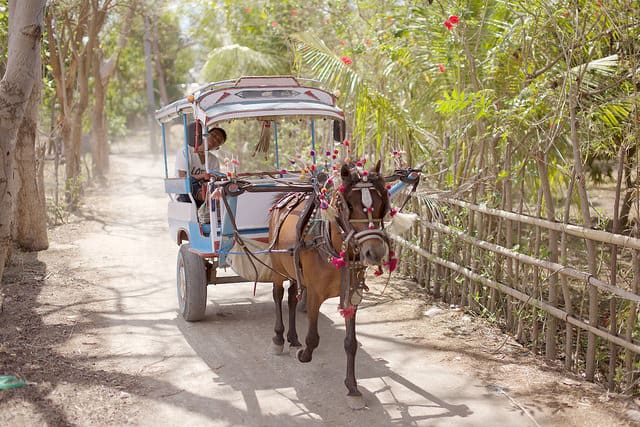
Although this is a very traditional style of transportation all throughout Indonesia, it’s more of a novelty than a practical means of transportation in Bali. It’s like riding in a tuk-tuk in Thailand; once you’ve used them a couple times you’re probably over it.
If you do take a dokar, the same negotiation tactics would apply as with an ojek.
Safety – safe
Price – depends on distance and negotiating skills
Convenience/time – slow, not practical as a daily solution
Helicopter (yes, this exists in Bali!)
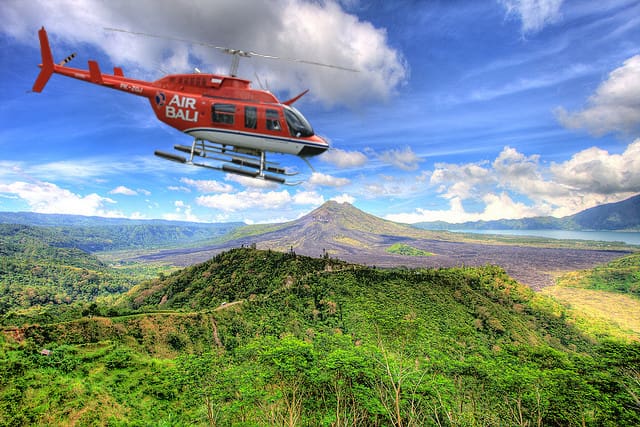
There is one well-known helicopter company available for hire that offers some limited transfer options and charters.
AirBali is by far the fastest and coolest way to get around Bali and the popular surrounding islands.
A transfer to Bali’s island of Nusa Lembongan costs approximately 3 million IDR/person ([convert number=3,000,000 from=”idr” to=”aud”] AUD / [convert number=3,000,000 from=”idr” to=”usd”] USD / [convert number=3,000,000 from=”idr” to=”eur”] EUR), with a minimum of 4 passengers required. They have approximately 14 transfer points within Bali in addition to their inter-island transfer and charter options.
To give you an idea, here is a 3-minute video of an expat having an AirBali trip:
Safety – safer than traveling in a car
Price – absolutely the most expensive
Convenience/time – the fastest method of transportation in Bali
Liability – fully insured
Public Transportation Options
While the options that follow are among the cheapest and safest, they are also the slowest and most underutilized, especially by foreigners.
Inherent with public transportation is the consideration of schedules, pick-up and drop-off locations, and comfort. Price is never an obstacle, yet convenience is paramount.
Each of the following options offers something different:
Kura-Kura Bus (privately owned minibus)
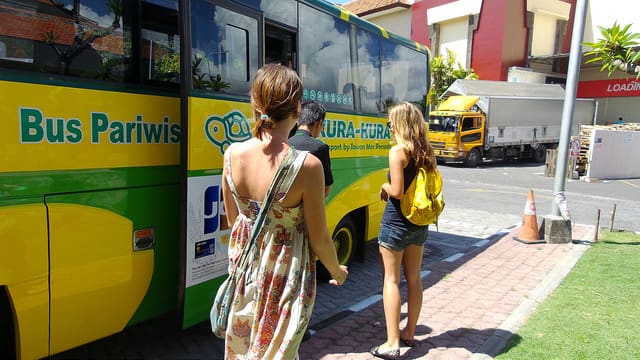
These modern buses are easily the best option for public transportation as far north as Ubud. The Kura-Kura buses stop along many of the most popular tourist areas of Bali. Don’t expect lightning speed here, as the name literally means ‘turtle’ in Indonesian.
All buses (there are 3 different sized buses) are equipped with air conditioning, power points for charging your devices, and wifi (don’t rely too heavily on it working all the time or fast speeds).
Cost: single fares range from 20,000 IDR to 80,000 IDR ([convert number=20,000 from=”idr” to=”aud”] AUD / [convert number=20,000 from=”idr” to=”usd”] USD / [convert number=20,000 from=”idr” to=”eur”] EUR to [convert number=80,000 from=”idr” to=”aud”] AUD / [convert number=80,000 from=”idr” to=”usd”] USD / [convert number=80,000 from=”idr” to=”eur”] EUR). They can be purchased on the bus directly. They also offer multiple day passes. You can purchase these online or at various ticketing locations.
All passengers are insured while on the bus. Please see their website for more detailed route information. www.kura2bus.com
Trans Sarbagita (large public bus)
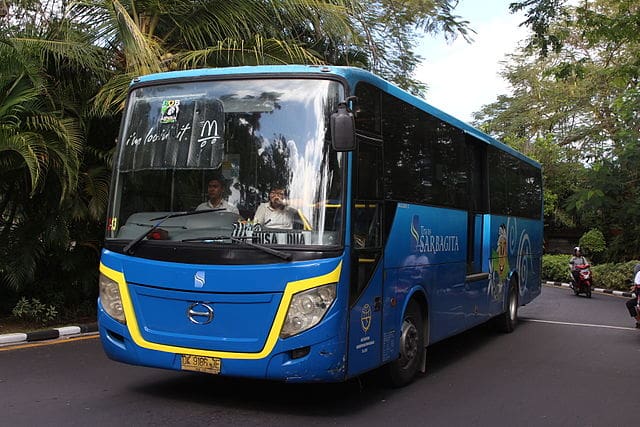
This is still a relatively young bus line with many new lines still ‘under planning.’ From time to time it’s mentioned in the news due to its underutilization and the possibility of certain routes being shut down.
The most popular 2 routes are from Batubulan (north of Sanur) to Nusa Dua and from Denpasar to GWK (GWK Cultural Park – Garuda Wisnu Kencana). There are feeder lines but don’t expect a lot of English to be used, nor a lot of organization.
Cost: single trips cost 3,500 IDR ([convert number=3,500 from=”idr” to=”aud” dp=”2″] AUD / [convert number=3,500 from=”idr” to=”usd” dp=”2″] USD / [convert number=3,500 from=”idr” to=”eur” dp=”2″] EUR) and the buses are airconditioned. Although the bus line doesn’t have a website of its own, you can find more info on Wikipedia via the following link. https://en.wikipedia.org/wiki/Trans_Sarbagita
There is usually an elevated bus stop with steps and a ramp and clear signage. The imperative word here being usually. Trans Sarbagita does NOT stop at the airport. The main terminal is in Denpasar and called Terminal (Bus) Ubung.
Bemo (older minibus/van)
A bemo is an older minibus that has benches instead of individual seats. They are regulated by the government and operate in both rural and urban areas of the island.
This is strictly for the adventurous budget backpacker. Fares are negotiable and typically start at around 5,000 IDR ([convert number=5,000 from=”idr” to=”aud” dp=”2″] AUD / [convert number=5,000 from=”idr” to=”usd” dp=”2″] USD / [convert number=5,000 from=”idr” to=”eur” dp=”2″] EUR).
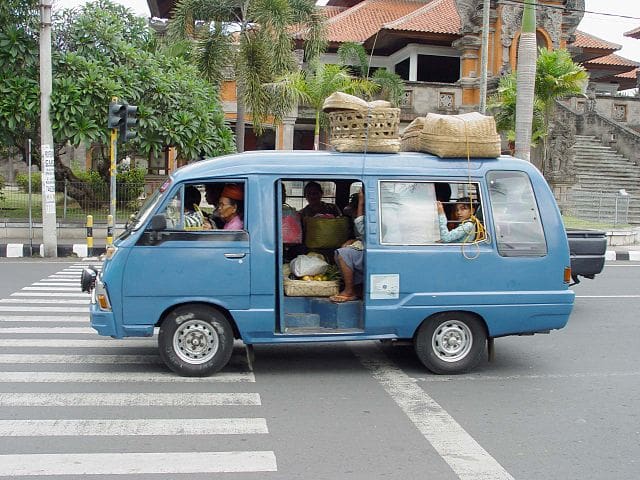
One could actually cover a lot of ground for very little money with the use of bemos. This will give you a glimpse into what Bali life is really like. Everyone should have a bemo experience but it probably won’t be something you’re going to opt for on a daily basis.
There is no air conditioning and these little vans can get pretty packed. There are no fixed bus stops and no fixed fares either. To catch one, you simply hail it down to stop like a taxi. Maybe it will stop maybe it won’t, that’s all part of the adventure.
Knowing where they are going is also an adventure in itself. You can ask when you get on, but don’t expect it to stop for more than just a moment while you try to figure it out.
Bemos typically operate on fixed routes; sometimes they will make small detours for a smiling bule. I’ve had one go out of the way to almost drop me at my desired location. Like I said, this is more for adventure and budget travel than it is practicality.
You can find a little more about the Bemo stops and routes here and here.
Safety – very safe
Price – cheapest option usually
Convenience/time – probably least convenient for tourists or expats. It’s really meant for budget conscious people (i.e. locals).
Transportation from Bali airport
Airport Pickups
It’s best to arrange a pickup directly through your hotel. These will likely be the same price or cheaper than the airport taxi monopoly. You can also find freelance drivers on the various Facebook Groups.
Travelers on a budget should walk out of the airport (through the parking garage and cross the main airport road exiting beyond the border fence) and hail a BlueBird as mentioned in the above section or see if you can find an ojek.
There are currently no buses from the airport.
If you do decide to brave the perils of driving in Bali, you can find the rentals available at Bali airport (Ngurah Rai International Airport in Denpasar) here: https://www.baliairport.com/car-rental/
Transportation from Bali airport to Ubud
A taxi from the airport to Ubud costs as much as hiring a car and driver for the day. Depending on your needs, the latter might make more sense. Booking an airport pickup with a car + driver before the trip should always be cheaper than a taxi.
Although the Kura-Kura bus line does run from the Kuta area to Ubud, you’ll still likely end up too far of a walk from the drop-off point. This really depends on where your accommodation is. Inquire directly when you’re booking your accommodation and the staff should have the best solution for you.
Uber is still an option, but you’d have to get out of the airport and be resourceful in finding wifi and a phone, as the driver won’t pick you up unless you can get them on the phone to confirm pickup location.
No definitive answers
There are no definitive answers (this is after all ‘the land of opportunism’), only pointers. You can also look at it this way: even if booking the car is a little more expensive than a taxi at the airport, you still won’t have to deal with the taxi mafia there, and you won’t have to wait.
The current rate for an airport taxi to Ubud is 300k rupiah, but if you’re arriving late they will likely ask more. Ok, so maybe this isn’t quite as much as a car + driver for the day, but given the nature of this corrupt monopoly, I can only urge people to seek alternative means of transportation. You can indeed find a driver for 400-450k for a day (8 hours).
Transportation from Bali to Lombok
Please refer to the website www.balitolombok.org.
Summing up
What do I use?
I have a car and motorcycle. I typically use the motorcycle more than the car due to time constraints. To go to the airport, I use Uber. When dropping off motorbikes for servicing, I use Go-jek to get a lift home and back when my bike is ready.
When shopping for groceries etc… I usually wait until sunday (typically the day with the least amount of traffic). Or I choose to I drive super early / later morning / early afternoon to avoid rush hours. I avoid driving late at night.
Conclusion
I hope you’ve found this information useful, yet it is only you who can decide which method or methods are best for your situation.
For those just visiting, it will likely be a combination of options. Just remember that money is not everything and your health and safety are far more important than anything else in this world.
Hati-hati dan Selamat Jalan!
Main Image (C) Jimmy McIntyre. CC License.
